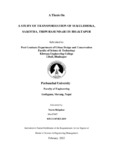Please use this identifier to cite or link to this item:
https://elibrary.khec.edu.np:8080/handle/123456789/519| Title: | A STUDY OF TRANSFORMATION OF SUKULDHOKA, SAKOTHA, TRIPURASUNDARI IN BHAKTAPUR |
| Authors: | Shilpakar, Neeru |
| Advisor: | Dr. Jharna Joshi, Ar. Libas Phaiju |
| Issue Date: | Feb-2022 |
| College Name: | Khwopa Engineering College |
| Level: | Masters |
| Degree: | MSc in Urban Design and Conservation |
| Abstract: | Transformation is a common occurrence in the city as a process of the continuous alteration on the different aspects namely physical, socio-cultural, socio-economic, cultural and religious. The development process in the urban form tends to change the city identify, as a result in which certain forces responsible for the transformation of urban form as the change in social structure and commercialization. The urban transformation of city occurred with establishment of different infrastructure at different time period. At the historical core area, the urban form transformation has also seen within the existing physical structure. The study area Sukuldhoka, Sakotha and Tripurasndari is at center of Bhaktapur, located at the main access route and this lane route as the part of Pradakshina Marga, jatra route. The study of the transformation of Sukuldhoka, Sakotha and Tripurasndari area is on the replacement of the historical traditional buildings by the modern buildings, usage of the space and the development of new commercial activities. The main objective of the research is to find the transformation of the urban fabric of the study area, its causes and impacts. For the study, a questionnaire survey, interview and observation was done on the area of 131 houses at Sukuldhoka square, along the street lane from Sukukdhoka-Sakotha, Sakotha –Balakhu, Balakhu-Tripurasundari-Sukuldhoka. And the commercial activities in the houses in the study area are also studied. Conclusion drawn for the urban form transformation is the increase in commercial activities and lifestyle of people. The current socio-economic trends have affected traditional system, as family size grew up they need more and more space as the growth of nuclear families over traditional joint family system leading to division of single family house among its family members. The main reason behind the decline of the old traditional buildings is not having the spaces as per the current requirements. The traditional building with inadequate rooms and size, so as an option residents move to the modern buildings outside the city core or the demolish it and convert with the modern concrete structures modifying as per their present demand and needs. But they hesitated to construct traditional load bearing buildings and prefer RCC frame structure as these are cost effective, easily availability of materials and workmanship, less wall thickness increasing usable space. The major factor for reduce of residence is the insufficient spaces with present requirement, family structure and property division. V The study also concerned with spatial characteristics defined by height, volume, scale and symmetry of street elevations. As observed on site, the spatial planning is still maintained to some extent but the height of buildings enclosing urban space is increasing vertically. Monuments and public buildings have maintained the original skylines and volumetric character, but for private buildings, it is opposite. The dominant buildings of modern and mix styles are mostly built against bylaws of Protected Monument Zone. Therefore, the increasing height and change in styles are discontinuation from original styles and skylines and such kinds of vertical expansion decreases utility of the open spaces leading to reduced values and livability of space. The economic development of the area with various types of shops and commercial organization like banks increasing the viability of area. The site being a commercial hub the different type of economic activity and forms are increasing, emerging the flow of visitors and traffic in site. Rise in the economic activity, vehicular movement escalates, vehicles, street vendors and pedestrians are struggling for space comprising as the size of street and node is same. Street side is also used for vehicular parking and deteriorating the visual environment and disturbing the vehicular and pedestrian traffic flow. In conclusion, transformations are taking place everywhere; it is at the global economic, political and social structures down to the way people fashion their everyday lives. Urban transformation is the changes in the built environment related to the human activity and the occupants in the area and aims to better the social, economic and spatial quality of the cities. This types of progress should not decline the original character and identities of the traditional settlement. |
| URI: | https://elibrary.khec.edu.np/handle/123456789/519 |
| Appears in Collections: | Master of Science (M.Sc) in Urban Design and Conservation |
Files in This Item:
| File | Description | Size | Format | |
|---|---|---|---|---|
| report-thesis-Neeru-2023-02-008-1.pdf Restricted Access | 11.3 MB | Adobe PDF |  View/Open Request a copy |
Items in DSpace are protected by copyright, with all rights reserved, unless otherwise indicated.
